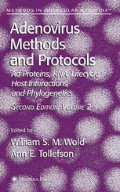Abstract
Microinjection of mammalian cells provides a powerful method for analyzing in vivo functions of viral genes and viral gene products. By microinjection, a controlled amount (ranging from several to many thousands of copies) of a viral or cellular gene, a protein product of a gene, a polypeptide fragment encoding a specific protein domain, or an RNA molecule can be delivered into a target cell and the functional consequences analyzed. Microinjection can be used to deliver antibody targeted to a specific protein domain in order to analyze the requirement of the protein for specific cell functions such as cell cycle progression, transcription of specific genes, or intracellular transport.
This chapter describes examples of the successful use of microinjection to probe adenovirus E1A regulatory mechanisms. Detailed methods are provided for manual and semiautomatic microinjection of mammalian cells as well as bioassay protocols for microinjected cells including immunofluorescence, colorimetic, in situ hybridization, and autoradiography.
Access this chapter
Tax calculation will be finalised at checkout
Purchases are for personal use only
References
Capecci, M. (1980) High efficiency transformation by direct microinjection of DNA into cultured mammalian cells. Cell 22, 479–488.
Shenk, T. (2001) Adenoviridae: the viruses and their replication, in Fundamental Virology, Lippincott, Williams and Wilkins, New York, pp. 1053–1088.
Lillie, J. W., Loewenstein, P. M., Green, M. R., and Green, M. (1987) An adenovirus E1 A protein region required for transformation and transcriptional repression. Cell 46, 1043–1051.
Green, M., Loewenstein, P. M., Pusztai, R., and Symington, J. S. (1988) An adenovirus E1 A protein domain activates transcription in vivo and in vitro in the absence of protein synthesis. Cell 53, 921–926.
Song, C-Z., Tierney, C. J., Loewenstein, P. M., et al. (1995) Transcriptional repression by human adenovirus E1 A N-terminus/conserved domain 1 polypeptides in vivo and in vitro in the absence of protein synthesis. J. Biol. Chem. 270, 23,263–23,267.
Stabel, S., Argos, P., and Philipson, L. (1985) The release of growth arrest by microinjection of adenovirus. EMBO J. 4, 2329–2336.
Kaczmarek, L., Ferguson, B., Rosenberg, M., and Baserga, R. (1986) Induction of cellular DNA synthesis by purified adenovirus E1A proteins. Virology 152, 1–10.
Ruley, H. E. (1983) Adenovirus early region 1A enables viral and cellular transforming genes to transform primary cells in culture. Nature (London) 304, 602–606.
Mulcahy, L. S., Smith, M. R., and Stacey, D. W. (1985) Requirement for ras protooncogene function during serum-stimulated growth of NIH 3T3 cells. Nature (London) 313, 241–243.
Dobrowolski, S., Harter, M., and Stacey, D. W. (1994) Cellular ras activity is required for passage through multiple points of the G0/G1 phase in BALB/c 3T3 cells. Mol. Cell. Biol. 14, 5441–5449.
Riabowal, K. T., Vosatka, R. J., Ziff, E. B., Lamb, N. J., and Feramisco, J. R. (1988) Microinjection of fos-specific antibodies blocks DNA synthesis in fibroblast cells. Mol. Cell. Biol. 8, 1670–1676.
Kovary, K., and Bravo, R. (1992) The jun and fos protein families are both required for cell cycle progression in fibroblasts. Mol. Cell. Biol. 11, 4466–4472.
Arias., J., Alberts, A. S., Brindle, P., et al. (1994) Activation of cAMP and mitogen responsive genes relies on a common nuclear factor. Nature (London) 370, 226–229.
Lawrence, J. B., and Singer, R. H. (1986) Intracellular localization of messenger RNAs for cytoskeletal proteins. Cell 45, 407–15.
Kislauskis, E. H., Li, Z., Singer, R. H., and Taneja, K. L. (1993) Isoform-specific 3'-untranslated sequences sort α-cardiac and β-cytoplasmic actin messenger RNAs to different cytoplasmic compartments. J. Cell Biol. 123, 165–172.
Harlow, E. and Lane, D. (1999) Using Antibodies. A Laboratory Manual. Cold Spring Harbor Laboratory, Cold Spring Harbor, New York.
Author information
Authors and Affiliations
Editor information
Editors and Affiliations
Rights and permissions
Copyright information
© 2007 Humana Press Inc, Totowa, NJ
About this protocol
Cite this protocol
Green, M., Thorburn, A., Kern, R., Loewenstein, P.M. (2007). The Use of Cell Microinjection for the In Vivo Analysis of Viral Transcriptional Regulatory Protein Domains. In: Wold, W.S.M., Tollefson, A.E. (eds) Adenovirus Methods and Protocols. Methods in Molecular Medicine™, vol 131. Humana Press. https://doi.org/10.1007/978-1-59745-277-9_12
Download citation
DOI: https://doi.org/10.1007/978-1-59745-277-9_12
Publisher Name: Humana Press
Print ISBN: 978-1-58829-901-7
Online ISBN: 978-1-59745-277-9
eBook Packages: Springer Protocols

